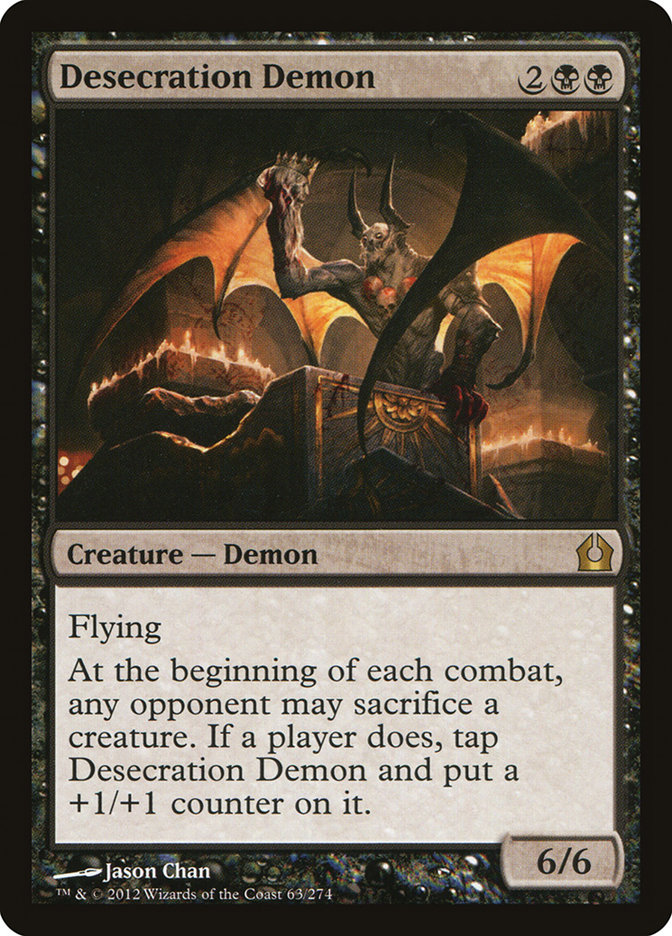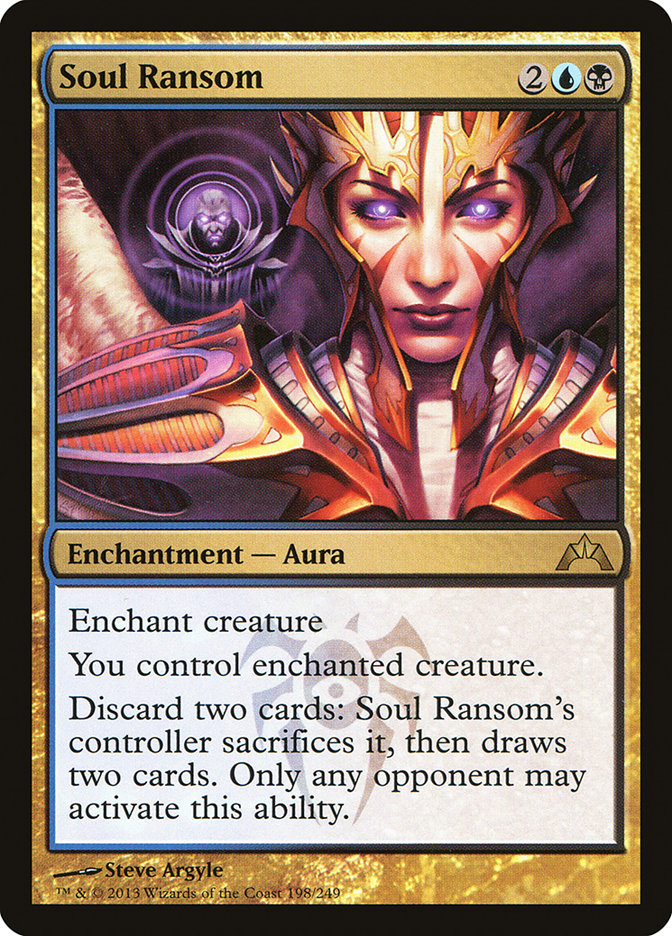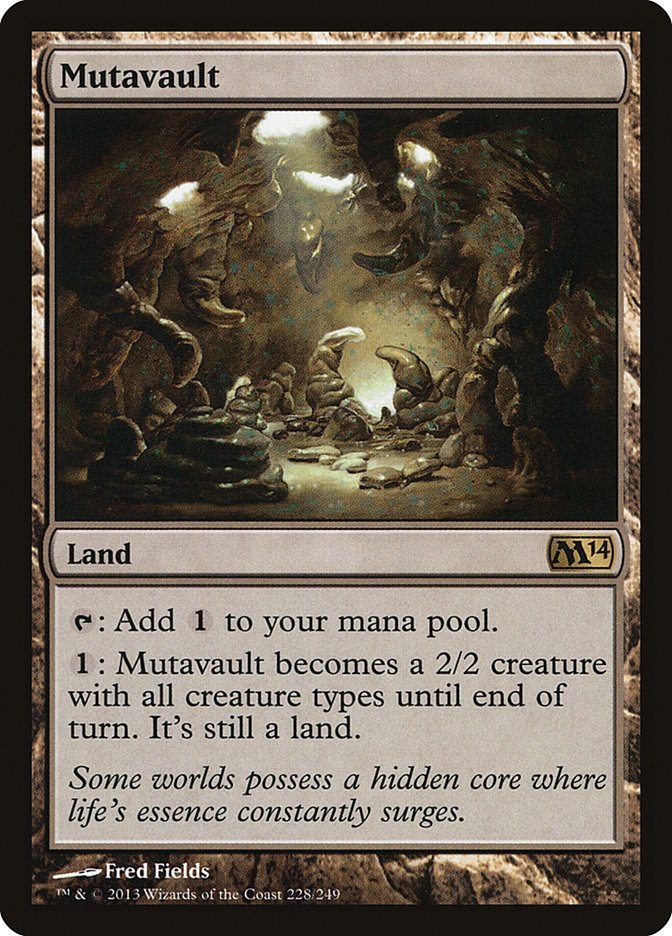Desecration Demon. A few weeks ago that was all I saw on my Twitter feed. (That and some stuff about steroids, performance-enhancing drugs, and Alex Rodriguez because I do follow a few non-Magic personalities.) Apparently, a particular sequence of plays at the World Magic Cup had stirred the Twitterverse, and it had everything to do with our good friend Desecration Demon and his triggered ability.
Before we get to the specifics of what happened at the WMC, I’d like to back up and recap where we are with our tournament policies on triggered abilities and what that means in this case. If you frequent Competitive REL events, you know that the trigger policy has gone through many changes in the past two years, some of them—can’t really mince words on this—terrible. But as I’ve said previously in this space, I think we are at a very happy place with triggers now, so I found it a little unusual that something had gone afoul with them. A brief recap of trigger policy:
You never have to remind your opponent about his or her triggers. If they forget to put a 3/3 Beast token onto the battlefield when their Thragtusk dies, they don’t get a token.
You cannot intentionally ignore your own triggers. Burning Earth, I’m looking at you. (Oh boy. That’s a completely different can of worms.)
Triggers are assumed to have happened unless the controlling player takes an action that makes it clear that it was missed.
There are various rules in place on when a trigger is considered missed. Judges know these rules, and you should call a judge if there is a dispute over whether a trigger has been missed or not. The important thing to remember is that a trigger isn’t necessarily considered missed if the player passes priority after it should have resolved (although that is the most common way to tell with the average trigger). This has been mostly relevant with creature pumping triggers like exalted and Jace, Architect of Thought’s +1.
Again, they are assumed to have happened until damage is dealt. A lot of players get tripped up on this part. “How can I make a blocking decision if I don’t know if my opponent has remembered their exalted triggers?” You can either assume that they remembered them all or ask your opponent, “How big is that creature?” And if you worry that this will give up the ghost and of course they will remember exalted if you ask a loaded question like that, then your focus is probably on the wrong aspects of the game.
This brings us to Desecration Demon. This card earned Level 5 Judge Toby Elliott ire as the worst trigger of all time in his blog here. The nod to it being a detrimental trigger is a determination that judges need to worry about when deciding whether to issue an infraction or not. (Most Missed Triggers no longer get Warnings unless they are, you guessed, detrimental.) Some judges argue that it isn’t a detrimental trigger because it sure is nice to get these shiny +1/+1 counters on your creature. That’s focusing on just one small aspect of the ability. Put another way, in what world do you want to play a card that taps itself?
If you’ve played against Desecration Demon online, you know the frustration of being asked if you want to sacrifice a creature every combat phase. Even if you set an auto-yield on the trigger, it will still ask you if you want to sacrifice a creature, and you’ll have to click through that prompt. This is just as true in real life. Trigger. Trigger. Trigger. Trigger. Being a detrimental trigger, the rules dictate that you must point it out every time it triggers. Otherwise, Warnings for you.
As an aside, it’s worth asking why it’s worded this way to be a trigger (or maybe it isn’t, as doing so may just hurt our brains). Couldn’t it have been an activated ability that only your opponent could activate? When I think of such abilities, my mind immediately goes to Lethal Vapors, although as it turns out that card allows you to activate it as well, leading to the famed “who gets to skip more turns?” corner case question (answer: the non-active player does). There’s actually a more recent card that has the requisite templating.
There you go. Desecration Demon could have had this type of wording—except that it would have led to some awkward situations. I’m sure there have been situations where a player just didn’t read Soul Ransom closely enough and never took their creature back. Maybe there have been situations on Magic Online where someone has activated the ability twice. There isn’t a set “time” when you should be activating Soul Ransom’s ability. Desecration Demon is different. You want to tap it at the beginning of combat to remove it from the combat equation, the same way you would use a Master Decoy to tap down your opponent’s Shivan Dragon.
Aside over. And yes, that did hurt my brain. So you miss a Desecration Demon trigger. What’s the worst that could happen with that? Let’s go to the video and find out.
On the left we have Enzo Real, who plays the Desecration Demon, and on the right is Vincent Lemoine. The Desecration Demon hits the battlefield at 11:40. Technically, the Demon triggers twice before we even get to the controversial turn, once on Enzo’s turn after he casts the Demon (unless he explicitly said that he was casting it in the post-combat main phase) and again on Vincent’s turn.
Based on the body language of the players, it’s safe to assume that there is no mention of those first two triggers. This is how people play the game in the real world. No one is going to point out triggers that don’t matter. Both players know that Vincent is not going to sacrifice his Snapcaster Mage, his only creature at the time, in order to tap down the Desecration Demon at those two points. The trigger policy does have a clause at the end that says “if a triggered ability would have no impact on the game, it’s not an infraction to fail to demonstrate awareness of it. For example, if the effect of a triggered ability instructs its controller to sacrifice a creature, a player who controls no creatures isn’t required to demonstrate awareness of the ability.”
Great—except that it doesn’t quite match this situation. If Vincent had no creatures, you could certainly make an argument that those triggers don’t matter. And if Vincent had an empty board but wanted to flash in a Snapcaster Mage in order to sacrifice it and tap down the Desecration Demon, he would be within his rights to make sure the trigger happened even if Enzo ignored it due to the “no creatures” clause. With one or more creatures on the board, we have a situation where the triggers could have an impact on the game even if it was strategically bonkers to sacrifice at those times. (Enter the “pump the Demon to later take it with Act of Treason” corner-case argument.)
So what’s up? Should Enzo be assessed a Warning for missing those unimportant-but-not-quite-irrelevant triggers? Technically, yes. Whenever I get into policy discussions and use the word “technically,” I perk up. My spidey sense goes crazy. Technically. That often means that the policy document supports the odd interpretation but we probably shouldn’t enforce it because of common sense. Call me a maverick, but I think that’s what Toby means when he says, “Judges—be prepared to hand wave a little bit.” As in hand wave those Warnings away, or at the very least don’t upgrade a third one to a Game Loss from Desecration Demon triggers. We don’t have matches degenerating into “gotcha, you forgot to point out yet another Desecration Demon trigger—I win!”
Back to the action. At the end of Vincent’s turn, Enzo tries to get rid of the Snapcaster Mage with Abrupt Decay. Vincent defends with a Restoration Angel, resetting his Snapcaster to fizzle the removal spell. Now we get to the critical turn. Again, if you’re just joining us in the video, start at the 13:00 mark.
At 13:10, Vincent makes a thumbs-up gesture. This is clearly in response to Enzo asking some variant of “combat?” Vincent is giving Enzo permission to attack. He’s holding off the Beast token with his Restoration Angel and is willing to let the Demon fly over for a hit here. Strategically, it makes sense. Because it gains counters with each sacrifice, you don’t want to start tapping down the Demon until it is absolutely necessary. After receiving Vincent’s approval to attack, Enzo taps his lands and casts Doom Blade on the Restoration Angel, now clearing the way for both the Desecration Demon and Beast token to come crashing in for nine.
But wait. The actions stops, and a judge gets involved. What happened? Since the video gives us a clear shot of Level 3 Judge Gianluca Bonacchi, I turned to my Italian friend for a first-hand account:
“[Enzo] had on the battlefield a Desecration Demon and another creature, while his opponent [Vincent] had a couple of creatures. [Enzo] asked if he could attack. His opponent said yes, but after that he wanted to play a Doom Blade and then declare attackers. My ruling was that by asking to attack he is giving priority until when the stack is empty in beginning of combat, so he is in the declare attackers step. He can’t play Doom Blade before declaring attackers (he can of course decide to attack and then to play it as an instant). The player complained that with his question he just wanted to resolve the trigger ability of Desecration Demon, but in my opinion he didn’t ask for that; he used a codified shortcut.”
That matches up with my audio-less interpretation of the sequence. The shortcut Gianluca refers to is this one from the MTR:
“A statement such as ‘I’m ready for combat’ or ‘declare attackers?’ offers to keep passing priority until an opponent has priority in the beginning of combat step. Opponents are assumed to be acting then unless they specify otherwise.”
Furthermore, the general philosophy of this and some other shortcuts is that “certain conventional tournament shortcuts used in Magic are detailed below. If a player wishes to deviate from these, he or she should be explicit about doing so.” This means that these are default shortcuts in any game of Magic. By declaring “combat?” Enzo was utilizing this shortcut, and according to Gianluca, Enzo did not acknowledge the Desecration Demon trigger in any way. When Vincent passed back with his thumbs up, the next action that Enzo needed to make was to declare his attackers.
This type of interaction was actually quite common in Lorwyn-era Constructed with Mutavault versus Cryptic Command. Player A has some number of creatures plus a Mutavault. Player A suspects that Player B has a Cryptic Command, so they ask to go into combat. If Player B casts Cryptic Command here, tapping all of Player A’s creatures, Player A can then activate Mutavault after that resolves and still attack for two (or more depending on the presence of Lords). If Player B doesn’t cast Cryptic Command and passes back, Player A can no longer activate their Mutavault and have it be part of the cavalry because they need to declare their attackers before they regain priority to activate abilities and / or cast spells. It’s a mini game of chicken. [Editor’s Note: And it was quite a fun one back in 2009.]
I want to go back to something that Gianluca mentioned; the correct sequence for Enzo here was to declare his attackers and then Doom Blade the Restoration Angel before blockers. Based on that, is it possible to interpret his actions as an Out-of-Order Sequencing? He does put the Doom Blade into his graveyard and then immediately move to tap his attackers. Or it seems immediate? It’s quite hard to get a true feel for the action taking place. Certainly a verbal “Doom Blade your Angel and attack” said all at once would be grounds for allowing the OOOS.
Based on Gianluca’s testimony, nothing was said. OOOS is a policy that is often used to interpret a sequence of quick and sloppy actions, like “attack with this Beast, this Wolf, and activate this Mutavault and attack.” (There’s that card again.) However, by explicitly moving through steps and phases, you can deny yourself the opportunity to do this. If you declare “combat” to fish for that Cryptic Command, you won’t be attacking with your Mutavault.
I want to end with a quick what you should do if you are:
The player who controls Desecration Demon – Make sure to explicitly announce your triggers, especially if you plan on attacking with it and your opponent has creatures on the battlefield. Ways to include this could include any of the following:
- Saying “trigger.”
- Saying “Demon.”
- Pointing to the card.
- Doing the Macarena. (No, not really.)
- Asking “do you want to sacrifice a creature to tap my Demon?”
The more explicit you are, the better. Asking to go to combat doesn’t work since as we saw earlier this is a standard shortcut and Desecration Demon is a decidedly un-standard card.
The opponent of the player who controls Desecration Demon – If you want to tap down the Desecration Demon with the ability, tell your opponent. If they shortcut to “combat,” the trigger could be considered missed, but as the opponent you have the right to put the trigger on the stack. You can do this by just telling your opponent that you are going to sacrifice a creature; there’s no need to involve a judge at this point because when your opponent passes to you, the trigger is still there waiting to resolve until you also pass and move into the declaration of attackers.
The judge called to a match – Should you give a Warning for a Missed Trigger? If this card starts seeing more play, this may be a question that we ask ourselves more and more. Judges, being the forward-thinking worrywarts that they are, have already been asking each other. This is one of those areas where judges will have to fall on the side of the “technically” and give Warnings because we need to apply policy equally and fairly. You players on the other hand aren’t bound quite so tightly. I encourage you not to call a judge for this unless you actually wanted to sacrifice a creature to tap the Demon and your opponent rushed through the trigger. If you tap the Demon on your opponent’s turn, there is no need to go and get a judge because they didn’t point out the trigger on your combat phase.
As always, leave your feedback here or find me on Twitter @mtgRikipedia.




